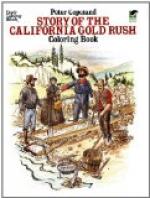Commodore Stockton sent Fremont and his men to San Diego and, taking four hundred soldiers, went himself to Los Angeles, where the native Californians and Mexicans were determined to fight against the rule of the United States. General Castro and his men and Governor Pico, the last of the Mexican governors, were driven out of the country. Stockton then declared that Upper and Lower California were to be known as the “Territory of California.”
In less than a month, however, the Californians in the south gathered their forces again and took Los Angeles. General Kearny was sent out with what was called the “army of the west,” to assist Fremont and Stockton in settling the trouble. Peace was declared after several battles, and Kearny acted as governor of the new territory, displacing Fremont. At last, by the treaty which closed the Mexican war in 1848 Alta California became the property of the United States, and Lower California was left to Mexico.
From that time there was peace and quiet, and before long the discovery of gold brought the new territory into great importance. The rush to the gold mines brought thousands of men, and as no government had been provided for the territory, Governor Riley in ’49 called a convention to form a plan of government.
This Constitutional Convention of delegates from each of California’s towns met in Monterey. The constitution there drawn up lasted for thirty years, and under it our great state was built up. It declared that no slavery should ever be allowed here, and settled the present eastern boundary line.
The first Thanksgiving Day for the territory was set by Governor Riley, in ’49. The first governor elected by California voters was Burnett, and in the first legislature Fremont and Gwin were chosen as senators. Congress at last admitted California into the Union by passing the California bill. On September 9, 1850, President Fillmore signed the bill.
Every year on the 9th of September, or “Admission Day,” we therefore keep our state’s birthday. At San Jose, in ’99, a Jubilee Day was held in remembrance of the beginning of state government fifty years before.
[Illustration: Upper Sacramento river.]
[Illustration: Placer gold mining. (Washing with Cradle.)]
THE DAYS OF GOLD AND THE ARGONAUTS OF 1849
California has well earned her name of “Golden State,” for from her rich mines gold to the value of thirteen hundred millions has been taken. Yet every year she adds seventeen millions more to the world’s stock of gold. No country has produced more of this precious yellow metal that men work and fight and die for. The “gold belt” of the state still holds great wealth for miners to find in years to come.
Long, long ago people knew that gold was here, for in 1510 a Spanish novel speaks of “that island of California where a great abundance of gold and precious stones is found.” In 1841 the Indians near San Fernando Mission washed out gold from the river-sands, and other mines were found not far from Los Angeles.




